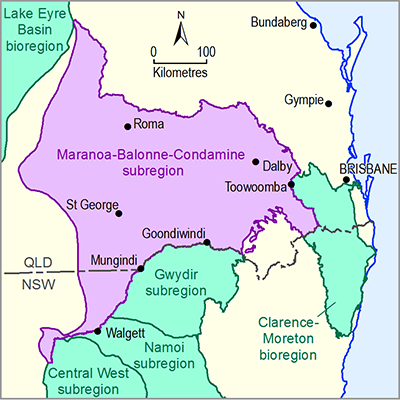Queensland’s OGIA regional groundwater model (QWC, 2012) played a central role in the hydrological analysis. The specific implementation of the model used was extended during this BA to include open-cut coal mines under both the baseline and the CRDP, compared to previous versions that only included CSG developments. The quantitative uncertainty analysis accounts for parameter uncertainty, but not conceptual model uncertainty. However, the combination of formal quantitative and qualitative uncertainty analysis techniques builds confidence in model predictions. Further, the model conceptualisation and parameterisation are conservative with respect to drawdown estimates.
The revised OGIA 2016 model addressed many of the limitations identified in the qualitative uncertainty analysis. Improvements include representation of regional geology, hydrostratigraphy and faults, as well as model discretisation, parameterisation and calibration. The patterns of long-term drawdown impacts are broadly consistent between the OGIA 2012 model used for BAs and the revised OGIA 2016 model. While this lends confidence to the BA model predictions, it is important to be aware of the difference in OGIA model versions given the proximity in timing of the completion of the hydrological modelling for the Maranoa-Balonne-Condamine subregion and the release of the latest underground water impact report (UWIR) for the Surat Cumulative Management Area (OGIA, 2016). The revised representation of hydrological changes in surficial aquifers that affect surface water – groundwater interactions and groundwater-dependent ecosystems (GDEs) are noted in particular as providing the greatest opportunities to reduce predictive uncertainty in the regional model.
The representation of near-surface geological layers in the OGIA model affects the propagation, through space and time, of drawdown that follows extraction of groundwater to enable CSG production and dewatering of open-cut mine pits. For example, the simplified regional hydrostratigraphy in the vicinity of the New Acland Coal Mine includes alluvium and Main Range Volcanics, but does not include the localised subcrop area of Walloon Coal Measures targeted by the mine. This leads to a smaller and less contiguous zone of potential hydrological change in the regional watertable near New Acland Coal Mine. In contrast, drawdown predicted near The Range coal mine is larger and spatially contiguous, where the regional watertable is represented by outcropping Walloon Coal Measures in the model.
The greatest opportunities to improve model predictions in this Assessment involve incorporation of surface water modelling and surface water – groundwater interactions to quantify changes in streams and the regional watertable that may occur as a result of coal resource development. Any assessment of changes in surface water that may occur as a result of coal resource development was limited to conceptual analysis and would need to be modelled numerically for changes to be quantified. Water quality models and data would allow related hazards to be addressed.

Product Finalisation date
- 3.1 Overview
- 3.2 Methods
- 3.3 Potential hydrological changes
- 3.4 Impacts on and risks to landscape classes
- 3.4.1 Overview
- 3.4.2 Landscape classes that are unlikely to be impacted
- 3.4.3 'Floodplain or lowland riverine (including non-GAB GDEs)' landscape group
- 3.4.4 'GAB GDEs (riverine, springs, floodplain or non-floodplain)' landscape group
- 3.4.5 'Non-floodplain or upland riverine (including non-GAB GDEs)' landscape group
- 3.4.6 'Human-modified' landscape group
- References
- Datasets
- 3.5 Impacts on and risks to water-dependent assets
- 3.6 Commentary for coal resource developments that are not modelled
- 3.7 Conclusion
- Citation
- Acknowledgements
- Contributors to the Technical Programme
- About this technical product
